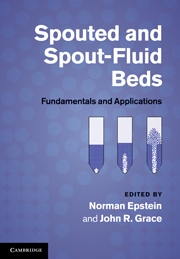Book contents
- Frontmatter
- Contents
- Contributors
- Preface
- Common nomenclature
- 1 Introduction
- 2 Initiation of spouting
- 3 Empirical and analytical hydrodynamics
- 4 Computational fluid dynamic modeling of spouted beds
- 5 Conical spouted beds
- 6 Hydrodynamics of spout-fluid beds
- 7 Spouted and spout-fluid beds with draft tubes
- 8 Particle mixing and segregation
- 9 Heat and mass transfer
- 10 Powder–particle spouted beds
- 11 Drying of particulate solids
- 12 Drying of solutions, slurries, and pastes
- 13 Granulation and particle coating
- 14 The Wurster coater
- 15 Gasification, pyrolysis, and combustion
- 16 Spouted bed electrochemical reactors
- 17 Scaleup, slot-rectangular, and multiple spouting
- 18 Mechanical spouting
- 19 Catalytic reactors and their modeling
- 20 Liquid and liquid–gas spouting of solids
- Index
- References
1 - Introduction
Published online by Cambridge University Press: 04 February 2011
- Frontmatter
- Contents
- Contributors
- Preface
- Common nomenclature
- 1 Introduction
- 2 Initiation of spouting
- 3 Empirical and analytical hydrodynamics
- 4 Computational fluid dynamic modeling of spouted beds
- 5 Conical spouted beds
- 6 Hydrodynamics of spout-fluid beds
- 7 Spouted and spout-fluid beds with draft tubes
- 8 Particle mixing and segregation
- 9 Heat and mass transfer
- 10 Powder–particle spouted beds
- 11 Drying of particulate solids
- 12 Drying of solutions, slurries, and pastes
- 13 Granulation and particle coating
- 14 The Wurster coater
- 15 Gasification, pyrolysis, and combustion
- 16 Spouted bed electrochemical reactors
- 17 Scaleup, slot-rectangular, and multiple spouting
- 18 Mechanical spouting
- 19 Catalytic reactors and their modeling
- 20 Liquid and liquid–gas spouting of solids
- Index
- References
Summary
This introductory chapter follows the contours, and in some cases even the exact wording, of Chapter 1 in Spouted Beds, the only book prior to the present publication that deals exclusively with this subject. Indeed, the current venture was originally to be a revised version of that 1974 book by the present editors. However, after writing the first draft of this chapter for the revision, we realized that the breadth and variety of work on spouted and spout-fluid beds since 1974 required input from a wide range of authors for coverage to be completed in a finite time. Changes in the subsequent draft were mainly with respect to layout of chapter topics (Section 1.6). Despite advances since 1974, the earlier book of that year remains a repository of useful information not available in this volume or elsewhere.
The spouted bed
Consider a vessel open at the top and filled with relatively coarse particulate solids. Suppose fluid is injected vertically through a centrally located small opening at the base of the vessel. If the fluid injection rate is high enough, the resulting high-velocity jet causes a stream of particles to rise rapidly in a hollowed central core within the bed of solids. These particles, after being carried somewhat beyond the peripheral bed level, rain back onto the annular region between the hollowed core and the column wall, where they slowly travel downward and, to some extent, inward as a loosely packed bed.
- Type
- Chapter
- Information
- Spouted and Spout-Fluid BedsFundamentals and Applications, pp. 1 - 16Publisher: Cambridge University PressPrint publication year: 2010
References
- 4
- Cited by



